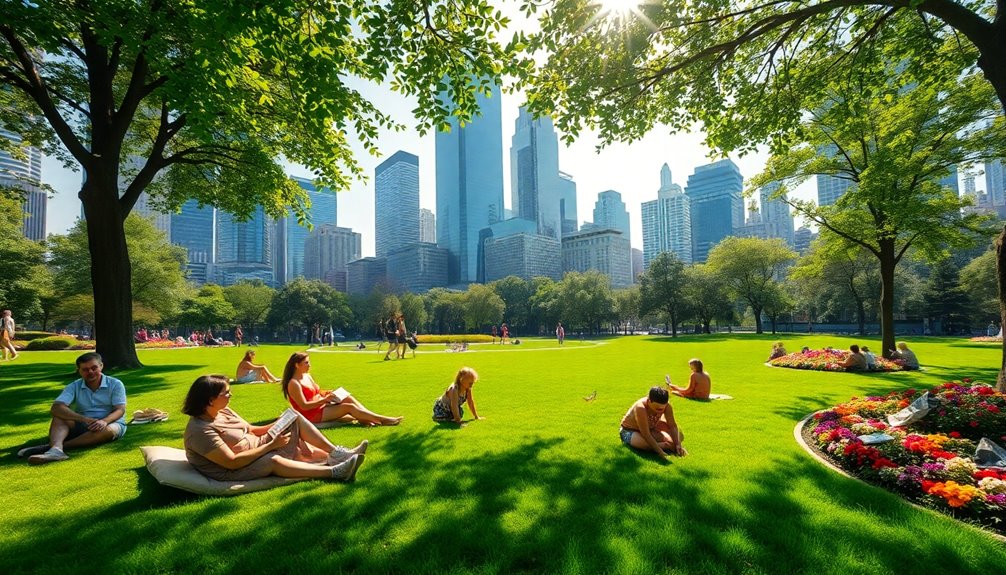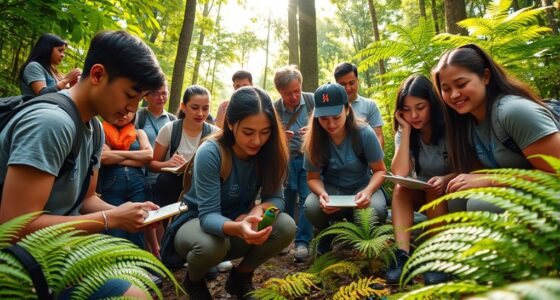Urban green spaces matter because they enhance your quality of life, improve air quality, and promote mental well-being. They offer places for relaxation, socialization, and physical activities like jogging or biking. You can connect with nature and your community through local events and volunteer opportunities. Moreover, green spaces can boost your neighborhood's economy and property values. Interested in how cities can expand these vital areas and reap even more benefits? Keep exploring!
Key Takeaways
- Urban green spaces enhance quality of life, providing areas for relaxation, socialization, and physical activity.
- They improve air quality, manage stormwater, and support biodiversity, contributing to a healthier environment.
- Spending time in green areas reduces stress, enhances mood, and promotes mental well-being.
- Green spaces foster community engagement by serving as venues for events and encouraging volunteerism.
- Economically, they attract visitors, boost local businesses, and increase property values in surrounding neighborhoods.
The Importance of Urban Green Spaces

Urban green spaces play a crucial role in enhancing the quality of life for city dwellers. They offer you a place to unwind, socialize, and connect with nature without leaving the urban environment.
Imagine stepping into a park, feeling the grass beneath your feet, and hearing birds chirping—it's a refreshing escape from the concrete jungle. These spaces encourage physical activity, whether you're jogging, biking, or simply taking a leisurely stroll.
They also foster community engagement, inviting you to join local events or meet neighbors. By providing a sanctuary for relaxation and recreation, urban green areas not only improve your mental well-being but also create a sense of belonging, making city living more enjoyable and fulfilling.
Environmental Benefits of Green Areas
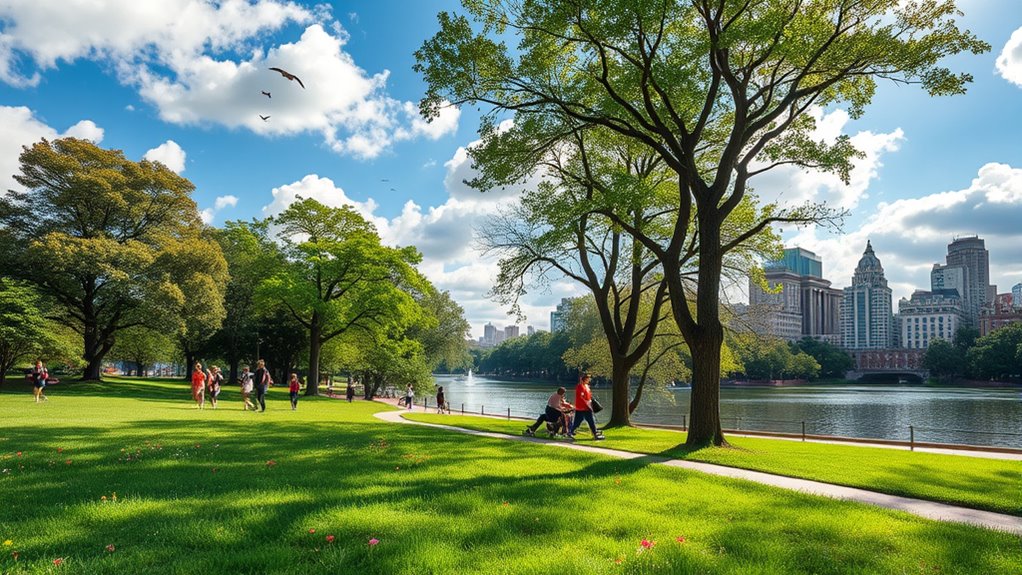
While you might appreciate the aesthetic appeal of parks and gardens, their environmental benefits are equally significant.
Green areas play a crucial role in improving air quality by absorbing pollutants and providing oxygen. They help reduce urban heat by offering shade and cooling the surrounding environment, making cities more comfortable during hot months.
Moreover, these spaces manage stormwater effectively, preventing flooding and reducing runoff. They also support biodiversity by providing habitats for various species, which is essential for a balanced ecosystem.
Additionally, greenery can help mitigate climate change by sequestering carbon dioxide. By incorporating more green areas into urban settings, you contribute to a healthier environment for yourself and future generations.
Enhancing Mental Health and Well-being
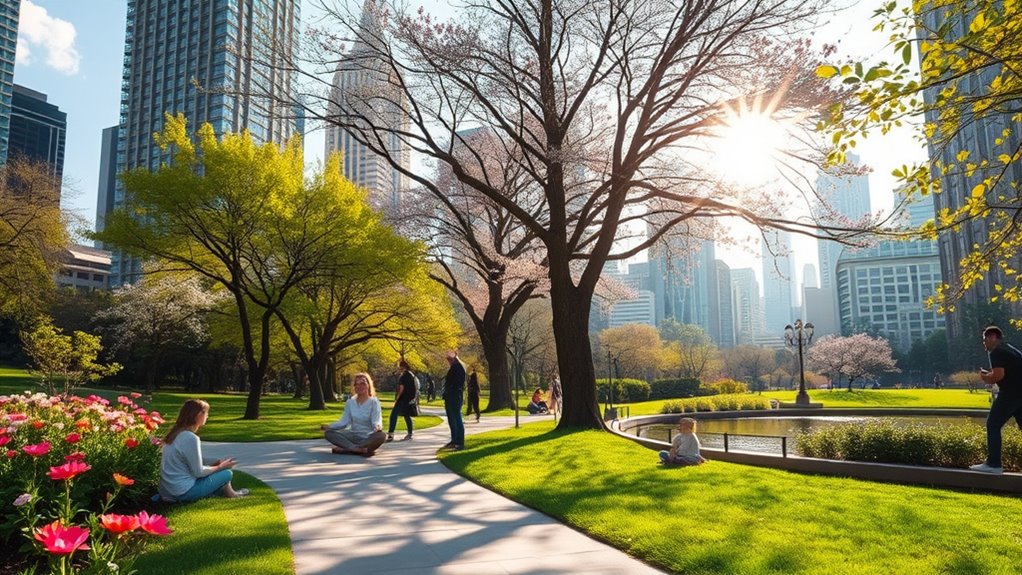
Spending time in green spaces can significantly boost your mental health and overall well-being. Nature has a unique way of reducing stress and anxiety, allowing you to recharge and find peace.
When you immerse yourself in natural surroundings, your mood improves, and you often feel more relaxed and focused. The sights and sounds of greenery can help clear your mind, enhancing your creativity and problem-solving skills.
Regular visits to parks or gardens can also improve your sleep quality, making you feel more energized. Plus, engaging in physical activities like walking or jogging in these spaces releases endorphins, which elevate your mood.
Promoting Community Engagement
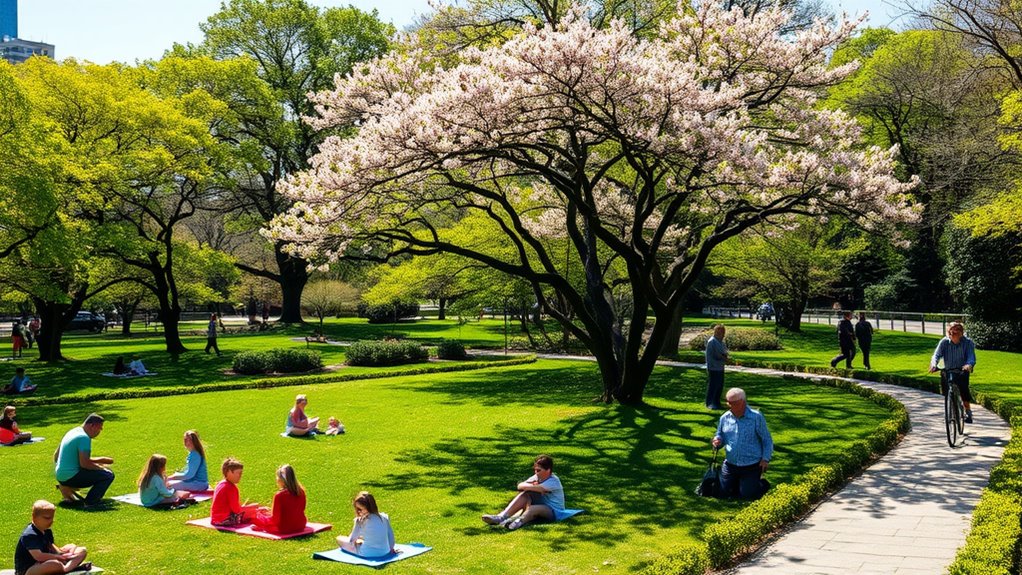
Green spaces not only enhance individual well-being but also serve as vibrant hubs for community engagement.
When you step into a park or garden, you're entering a space that invites connection. You can join in on community events, from yoga classes to local farmers' markets, fostering relationships with your neighbors. These interactions help build a sense of belonging and strengthen community ties.
You might even find opportunities to volunteer for park clean-ups or gardening initiatives, empowering you to contribute to your environment. By participating in these activities, you're not just enjoying nature; you're actively shaping your community.
Economic Advantages of Green Spaces
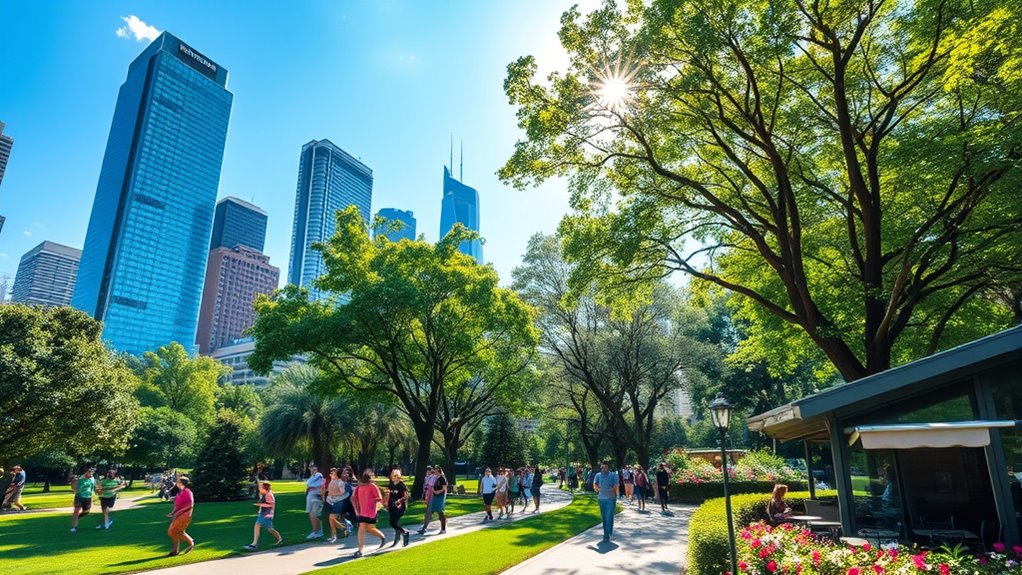
Urban parks and gardens aren't just beautiful; they can also boost local economies. When you invest in green spaces, you're creating attractive areas that draw visitors and encourage local spending.
Restaurants, shops, and businesses near parks often see increased foot traffic, leading to higher sales. Plus, these spaces can enhance property values, making neighborhoods more desirable. Homebuyers often look for areas with access to parks, contributing to a healthy real estate market.
Additionally, green spaces can create jobs, from maintenance to events, further stimulating the economy. By prioritizing urban greenery, you're not just improving the quality of life; you're also laying the groundwork for economic growth in your community.
Embracing green spaces is a win-win for everyone involved.
Biodiversity and Urban Ecosystems
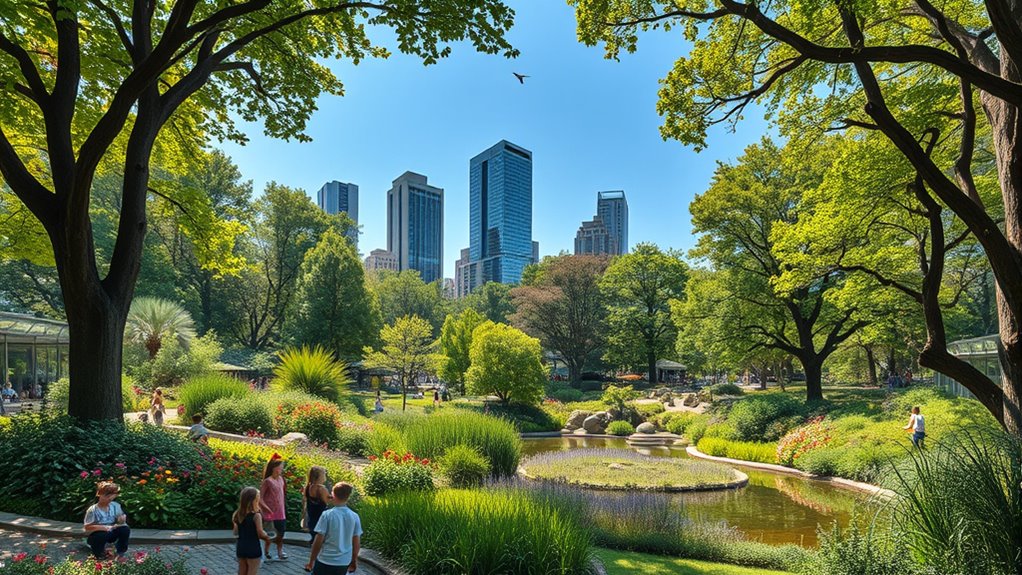
Investing in green spaces does more than boost local economies; it also plays a vital role in enhancing biodiversity and supporting urban ecosystems.
When you create parks and gardens, you're providing habitats for various species, from birds to pollinators. These vibrant ecosystems help maintain ecological balance and promote healthy air and water quality.
By incorporating native plants, you attract local wildlife, which can thrive in urban settings. This not only enriches your community's natural beauty but also fosters a connection between residents and nature.
Plus, diverse ecosystems can help mitigate the impacts of climate change, making your city more resilient.
Ultimately, your commitment to green spaces nurtures a thriving environment for both people and wildlife.
Strategies for Expanding Green Areas in Cities
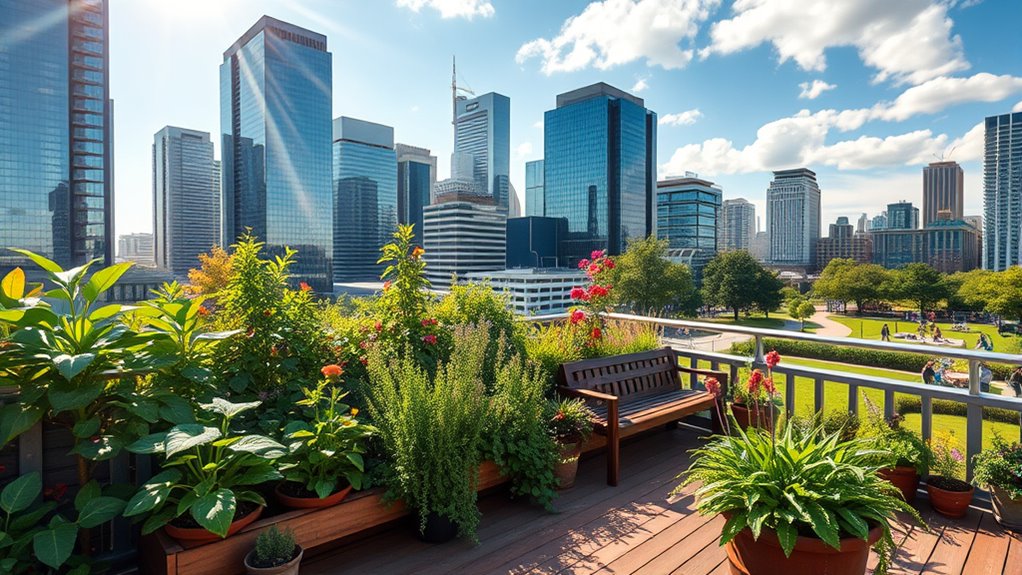
As cities continue to grow, finding effective strategies for expanding green areas becomes essential for enhancing quality of life. One approach is to repurpose underutilized spaces, like vacant lots or rooftops, turning them into community gardens or parks.
You can advocate for policies that prioritize green infrastructure in new developments, ensuring every neighborhood has access to nature. Collaborating with local organizations can also help mobilize resources for planting trees and creating green corridors.
Engaging residents in tree-planting events fosters a sense of ownership and community pride. Finally, consider promoting urban agriculture initiatives, which not only provide fresh produce but also increase green space.
Frequently Asked Questions
How Do Urban Green Spaces Impact Property Values?
Urban green spaces significantly impact property values.
When you live near parks or gardens, you'll often notice higher demand for homes in those areas. People appreciate the aesthetic appeal and recreational opportunities these spaces provide, which can lead to increased property prices.
You're likely to find that homes close to green areas sell faster and at a premium compared to those further away, making these spaces a valuable asset in real estate.
What Role Do Green Spaces Play in Urban Planning?
In urban planning, green spaces play a crucial role by enhancing community well-being and fostering social interaction.
They provide a necessary escape from the concrete jungle, helping you relax and recharge. You'll find that these spaces improve air quality and promote biodiversity, which can lead to healthier neighborhoods.
When planners prioritize green spaces, they create vibrant communities that attract residents and businesses alike, ultimately boosting the area's overall appeal and livability.
How Can Citizens Advocate for More Green Spaces?
You might stand in a concrete jungle, craving a breath of fresh air, or you might stroll through a park, feeling revitalized.
To advocate for more green spaces, start by joining local community groups who share your vision. Attend city council meetings, voice your thoughts, and gather signatures for petitions.
Collaborate with neighbors to demonstrate support, and don't underestimate the power of social media to raise awareness and inspire change.
What Types of Plants Are Best for Urban Areas?
When choosing plants for urban areas, consider native species that thrive in local conditions.
These plants require less water and maintenance, making them ideal for busy city life.
Think about incorporating drought-resistant varieties, such as succulents and ornamental grasses, which can handle heat and limited resources.
Don't forget about pollinators; adding flowering plants like bee balm and coneflowers can support local ecosystems while enhancing your urban landscape's beauty and biodiversity.
How Do Green Spaces Affect Local Wildlife?
Green spaces significantly boost local wildlife habitats.
When you create parks or gardens, you're offering shelter and food sources for birds, insects, and small mammals. These areas help maintain biodiversity by connecting fragmented habitats, allowing animals to thrive.
You might notice more butterflies and birds visiting your yard or nearby parks.
Conclusion
In a bustling city, imagine a single tree standing tall amid concrete and chaos. That tree not only provides shade but also a breath of fresh air for your weary soul. Urban green spaces are like that tree—they're essential oases that nurture your mental health, foster community ties, and support wildlife. By prioritizing these green areas, you're investing in a healthier, happier city for everyone. Let's cultivate these vital spaces and watch our urban environments thrive together.
